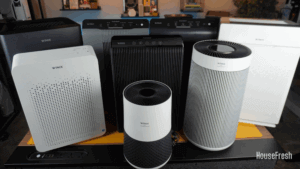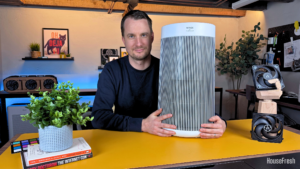The Winix 5500-2 is an upgraded version of their super popular Winix 5300-2, which we reviewed in 2021. It’s a device that has many fans online, from the team from NYtimes Wirecutter to the Redditors over at r/AirPurifiers.
Winix is one of the OG air purifier manufacturers, producing air quality devices since 1973. They are a South Korean company known for creating budget-friendly products that still perform effectively. It’s worth also mentioning that all Winix devices are made in Korea rather than China (the usual manufacturing country of most air purifier brands).
Another highlight of Winix is that they send all their devices for independent testing with AHAM (Association of Home Appliance Manufacturers) Verifide, which means that a third party has confirmed the unit’s CADR results.
As always, let me clarify that we bought the 5500-2 with our own money and have no relationship with Winix. We do this because we want to be as unbiased as possible, letting our first-hand data guide us. That is why my review focuses on how this unit performed in our set of tests, including its air cleaning performance, long-term costs, energy usage and sound generation.
A few weeks ago, we started hearing rumors about the 5500-2 being discontinued so we reached out to Winix America for confirmation.
Unfortunately, the rumors are true: both the Winix 5500-2 and the 5300-2 will be discontinued in the U.S. and in Canada once their inventory comes to an end.
The lowdown on the Winix 5500-2

What we really like
What we think could be better
| HouseFresh rating: | ★★★★★ |
| Time to clean our 728 cubic feet test room (with the device running at top speed): | 23 minutes (with PlasmaWave) |
| Air purifier technology: | PlasmaWave, removable pre-filter, washable activated carbon filter and True HEPA filter |
| Recommended room size (4.8 air changes per hour): | 360 sq. ft. |
| Clean air delivery rate (CADR): | Dust: 243 CFM Smoke: 232 CFM Pollen: 246 CFM |
| Dimensions (in inches / cm): | 15W x 8.2D x 23.6H inches (38W x 21D x 60H cm) |
| Weight (in pounds / in kg): | 14.8 lbs (6.7kg) |
| Filter life: | 12 months |
| Noise level in decibels (measured from 3 ft. away with a sound level meter): | Speed 1: 38.8 dB Speed 2: 42.5 dB Speed 3: 47.5 dB Speed 4: 58.9 dB |
| Electricity consumption in watts (recorded with an electricity usage monitor): | Standby mode: 0.34 watts Speed 1: 6.5 watts Speed 2: 9.11 watts Speed 3: 14.80 watts Speed 4: 53.46 watts |
| Estimated running cost (electricity consumption + official filter replacement): | $161.53 per year |
| Cost per CADR cfm (based on dust CFM as reported by AHAM): | $0.66 |
| Manufacturer’s warranty: | 2 year |
| Country of manufacture: | South Korea |
The best feature: it comes with an ionizer that can be disabled
It may seem like a small thing, but unfortunately, there are many air purifiers on the market that come with hidden ionizers that cannot be turned off.

The Winix 5500-2 uses a bipolar ionization technology called PlasmaWave, but you can switch it off and still use the air purifier without this ionizer function. This is great to see because not everyone wants to use this type of technology due to the potential risks associated with it, such as ozone generation and the potential for it to introduce VOCs into the air.
Now, this is the point where Winix would correct me and say that I shouldn’t use the word ‘ionizer’ because, unlike normal ionizers that generate negative ions, their PlasmaWave technology produces both negative AND positive ions. However, even bipolar ionization technology can potentially introduce unwanted chemicals into the air.
The good news is that the Winix 5500-2 has been certified by the California Air Resource Board, meaning that this unit meets the ozone emission concentration limit of 0.050 parts per million (50 ppb). That being said, some people report negative reactions to PlasmaWave, which is why it is great to have the option to disable it.
Timeless style that fits anywhere
The twin brother of the 5300-2 for those who prefer black over grey.

While the older 5300-2 is gray, the 5500-2 is black. I prefer this color as it doesn’t stand out as much, but then again I have a black phone, black car and black laptop — so I must really like black.
I’m a fan of the dark color but if you prefer lighter colors, the C545 could be worth a look as it’s a very similar device but in white.
Whilst it’s not a small device, its design means that it doesn’t take up too much floor space.
But apart from the color, the 5500-2 looks very similar to its predecessor and has the same product dimensions and floor space requirements.

Like the 5300-2, the 5500-2 keeps the useful removable pre-filter, which makes it super easy to remove to clean as you can quickly vacuum it or rinse it under the tap. Winix recommends you do this every three months to remove particle build-up and keep the unit running smoothly. Data from CleanAirStars has shown that HEPA particle removal efficiency can drop up to 40% when you fail to keep the pre-filter clean.
Another thing worth mentioning about the pre-filter in the 5500-2 is that it is much better than the fitted pre-filters seen on the Levoit Core devices, which are part of the main filter.

The control panel is similar to the 5300-2 with a button for auto mode and sleep mode, a button to switch on PlasmaWave, a button to cycle through the 4 fan speeds and a timer button to set 1 hour, 4 hours or 8 hours running time. There is a light underneath the buttons that adjust color depending on the current air quality levels.

One annoying thing about the older unit was that when you lost power, it would default back to using the PlasmaWave even if you had switched it off before. Sadly, the 5500-2 still has this issue, so you must adjust the settings again whenever you lose power. We have seen that Alen has managed to build in a setting memory, so it would be great to see this in place for future Winix devices.
One little thing I think is cute is the sound it makes when you switch it on and off. It seems to be a thing with Korean devices as my LG washing machine also does the same thing.
One benefit over the Winix 5300-2 is that the Winix 5500-2 comes with remote control, so you have that as an option:

Be aware if you have small children that the batteries used in these remotes can be deadly if ingested.
Three-stage air cleaning filter system
The 5500-2 comes with three separate filters, including a washable pre-filter, a washable pelleted activated carbon filter and a True HEPA filter.

Following the big issue of Levoit removing HEPA from their marketing after Dyson complained to the BBB National Programs National Advertising Division (NAD), I am definitely wary of manufacturers’ claims of HEPA.

One reason to trust the Winix 5500-2’s performance is that it’s been independently tested by AHAM as part of their Verifide process.
AHAM is the gold standard when it comes to air cleaning testing and I really like that Winix always sends their devices for a CADR test and the results for the 5500-2 are impressive.
- Dust CADR of 243 cfm
- Smoke CADR: 232 cfm
- Pollen CADR 246 cfm
Based on these results this device will provide 4.8 air changes per hour in spaces up to 360 square feet. So if you have a large space you might need a larger device or need to use multiple units.
Winix states that their True HEPA filter can remove 99.99% of particles of 0.3 microns. This is a big claim, but Winix brought receipts: their True HEPA filter has been tested by a third-party lab, so I am not worried that they are not using the filters they say.

One of my biggest issues with the older Winix was the material they used for the activated carbon filter. Winix chose to use impregnated carbon fabric, which is much cheaper and fine for light-duty issues with odors and gasses. However, ASHRAE recommends that granular media filters are better for medium-duty issues, which most homeowners will face.
I am glad to report that the 5500-2 has removed the impregnated media-infused carbon filter in favor of the granular type with activated carbon pellets.

I asked Teddy to take a close-up shot of the filter so you can clearly see the activated carbon pellets:

Winix states that you can clean these new activated carbon filters every three months by running them under water and then making sure to let them dry completely before putting them back into the device.
You can see the difference between the carbon filters in the Winix 5300-2 compared to that of the Winix 5500-2 in the image below:

As with many air purifiers, the filters for the Winix 5500-2 come inside plastic packaging that must be removed before use. If you don’t remove the plastic bags, the air purifier will move dirty air around your room without cleaning it, potentially worsening allergies.
Removing filters for the Winix 5500-2 is super easy once you have removed the pre-filter from the tabs. Be sure to always put the activated carbon filter in first and then the True HEPA filter.
The Winix 5500-2 cleaned our test room in 23 minutes
The Winix 5500-2 has one the best bang for your buck when it comes to top speed air cleaning performance
Testing air cleaning performance at top speed
For our test, I used the PurpleAir Zen sensors with an additional BM680 gas filter, which allows us to track PM1, PM2.5, PM10 and VOC levels continually.
I first filled our 728-square-foot test room with smoke from burning an incense stick and then switched on the Winix 5500-2 in its highest mode with PlasmaWave enabled.
We tested the Winix 5500-2 in the same area where we tested 90 other air purifier models, all of which do the same job of removing particles from incense smoke.
By testing every air purifier in the same room doing the same job we make it much easier to compare performance across different brands and models.
We have a program that connects to Purple Air air quality sensors and creates a graph showing the levels of PM1, PM2.5 and PM10.
One of the main questions we see online is how well the Winix 5500-2 can clean the air without using the PlasmaWave ionizer function.
We decided to test this ourselves and were pleased with the results as it was still able to clean our test room of PM1 particles in 24 minutes without the PlasmaWave, which is three minutes faster than Wirecutter’s top recommended air purifier: the Coway AP-15122hh Mighty (with its ionizer enabled).
I created a table to compare how the Winix 5500-2 compares with other air purifier models we have benchmarked:
| AIR PURIFIER MODEL | TIME TO REACH PM1 ZERO AT FULL SPEED | LIST PRICE |
|---|---|---|
| AirFanta 3Pro | 17 minutes | $159.99 |
| Levoit Vital 200S | 23 minutes | $189.99 |
| Winix 5500-2 (with ionizer) | 23 minutes | $249.99 |
| CleanAirKits Luggable XL-7 | 23 minutes | $299.00 |
| Smart Air SA600 | 24 minutes | $279.95 |
| Coway Airmega AP-1512HH (with ionizer) | 26 minutes | $229.99 |
| PuroAir 400 | 30 minutes | $249.00 |
| Corsi-Rosenthal Box | 32 minutes | $85.00 |
Testing air cleaning performance at sub-45 dB
Since we first published this review, we have received many requests for information on air cleaning performance at low fan speeds. This makes sense, as the top speed is unlikely to be used regularly, as most people will find it too loud. We used the 45 dBA limit that CleanAirStars sets for noisy classrooms.
For the Winix 5500-2, fan speed 2 is under 45 dBa (42.5 dBA). When we tested the Winix 5500-2 using Plasmwave at clearing incense smoke from our 728 cubic feet test room at speed 2, it needed 45 minutes to achieve PM1 zero, according to our Purpleair Zen sensor.
If you were wondering the effect Plasmwave had on the air cleaning performance, we tested again at Speed 2 with Plasmwave disabled it managed to achieve PM1 zero in 46 minutes so only 1 minute slower.
Noise level test results
The last test is to see how much sound is generated when using the purifier, especially at its highest and lowest fan speeds. The quieter an air purifier, the more likely you will use it, which will mean cleaner air in your home.
Here are the sound level results from 3ft away:
| Mode | Sound Level |
| Speed 1 | 38.8 dBA |
| Speed 2 | 42.5 dBA |
| Speed 3 | 47.5 dBA |
| Speed 4 | 58.9 dBA |
Check out how this compares to other air purifiers we tested in the table below:
| AIR PURIFIER MODEL | SOUND LEVEL AT TOP SPEED (dB) | TIME TO CLEAN OUR TEST ROOM |
|---|---|---|
| Smart Air Blast Mini MKII | 56.3 dB | 15 minutes |
| Levoit EverestAir | 57.8 dB | 16 minutes |
| Coway Airmega AP-1512hh Mighty | 60.1 dB | 25 minutes |
| IQAir Healthpro Plus | 61.2 dB | 28 minutes |
| Winix 5500-2 | 58.9 dB | 23 minutes |
| AirDoctor 3000 | 63.6 dB | 20 minutes |
We know the sound is highly subjective, so be sure to listen to the sound test we produced after testing the Winix 5500-2:
The cost to run a Winix 5500-2: $137.81 per year
1. Electricity costs = $57.82 per year
At the lowest fan speed, the Winix 5500-2 only pulled 6.5 watts per our energy meter and reached a maximum of 53.46 watts on its turbo speed with Plasmawave enabled.
Assuming energy prices of $0.174/kWh, running the 5500-2 continuously 24 hours per day for every day of the year would add $57.82 to your annual electricity bill. Most people will find that they will use the unit for less time than in our scenario, but others with issues with allergies might need to keep it running continuously.
| Fan speed | Energy consumed (ionizer enabled) |
| Standby | 0.34 watts |
| Sleep | 3.43 watts |
| 1 | 66.5 (7.1) watts |
| 2 | 9.11 (9.2) watts |
| 3 | 14.80 (15.00) watts |
| 4 | 53.46 (53.8) watts |
2. Filter costs = $79.99 per year
The genuine True HEPA and activated charcoal filters will need replacing every 12 months and have an RRP of $79.99 but are regularly available for close to $50 with sales and discounts. When I wrote this review, you could buy filters from Winix for $49.99 and Amazon for $43.99.
There are plenty of generic filters that bring the price down even more, with a year’s worth of filters costing close to $15 per year if you buy in a pack of four or $19 for a pack of two.
In the table below, we compare running costs with other similar performing air purifiers we have tested:
| AIR PURIFIER MODEL | ESTIMATED ELECTRICITY COST (per year) | FILTER REPLACEMENT COST (per year) | YEARLY MAINTENANCE COST |
|---|---|---|---|
| CleanAirKits Luggable XL-7 | $12.22 | $45.94 | $58.16 |
| Levoit Vital 200S | $46.83 | $49.99 | $96.82 |
| Coway Airmega AP-1512hh Mighty | $83.64 | $39.99 | $123.63 |
| AirFanta 3Pro | $46.56 | $78.67 | $125.23 |
| Levoit Core 400S | $27.44 | $99.98 | $127.42 |
| Winix 5500-2 | $57.82 | $79.99 | $137.81 |
| PuroAir 400 | $77.75 | $89.00 | $166.75 |
| Smart Air SA600 | $56.55 | $141.47 | $198.02 |
Bottom line: Is the Winix 5500-2 worth it?
The 5500-2 impressed me with its improved performance and use of pelleted activated carbon instead of the fabric we saw in the 5300-2.
The 5500-2 comes with an ionizer via its PlasmaWave technology that helps deal with odors and gases. However, it still offers great air cleaning performance even without using this function, as it removed all PM1 in our test in under 23 minutes without PlasmaWave enabled.

Filter prices are fair, considering the use of activated carbon pellets. Due to the device’s popularity, there are many choices for generic filters if you want to save more money in the long term. I much prefer the 5500-2’s removable pre-filter, which makes it much easier to clean and vacuum, than Levoit Core devices like the 400S and the 600S, which have the pre-filter integrated into the main filter.
It is worth mentioning that this air purifier doesn’t have app support, but it does have auto-mode. Just remember to keep the sensor clean of dust to ensure it works effectively.
For the price, the Winix 5500-2 is one of the top air purifiers – especially considering the amount of pelleted activated carbon it comes with. It offers excellent air cleaning performance, relatively low long-term costs and minimal noise generated. If you prefer different colors, you may be interested in the Winix C545, and if you don’t care about the particle filters, you can save a little money with the grey Winix 5300-2, which is usually sold cheaper but has a less effective gas filter.
It is unfortunate to learn that Winix has decided to discontinue this air purifier as it was one of my top recommendations due to the incredible value for money that it offers. If you like what the 5500-2 has to offer, make sure to check out the Winix 5510 (left).

This new model from Winix packs the same air cleaning power as the 5500-2 in a smaller and better-looking package, with app connectivity and an on-board air quality sensor. Read my full review of the 5510 to find out more.
If you have the Winix 5500-2 or have any other questions I haven’t covered, be sure to let me in the comments section below.
SOURCES
We calculated the yearly costs associated with running the Winix 5500-2 for 24 hours a day, 365 days per year, utilizing the latest average energy prices reported by the Bureau of Labor Statistics of $0.17/kWh as of November 2024.






